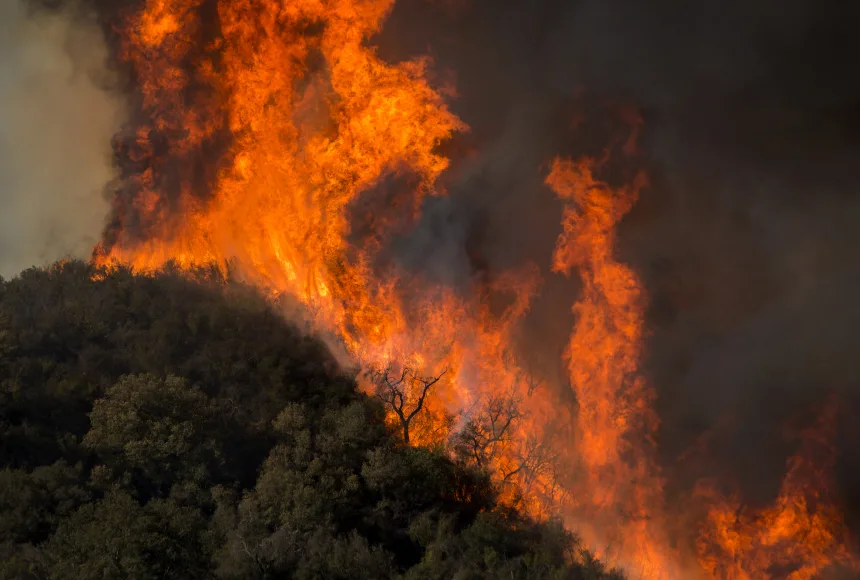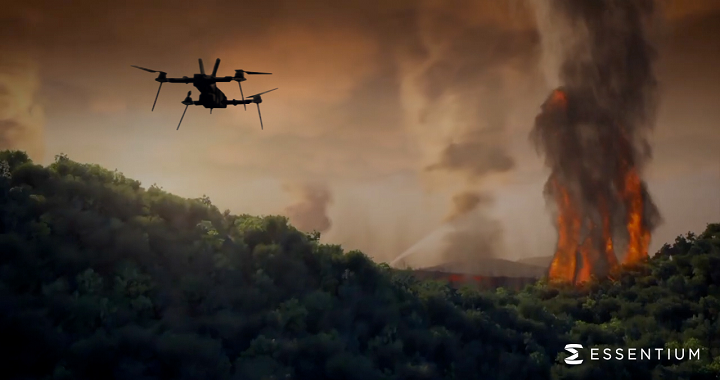Every year in the U.S., thousands of wildfires burn millions of acres of land, cause billions of dollars worth of damage, and often result in human casualties. Public safety technology developer Axle Box Innovations is helping enable and support the development of rugged 3D printed drones to manage and protect against dangerous wildfires, and it’s using Essentium AM technology to do it.
While wildfires can occur naturally from lightning strikes and excessive heat from the sun, NC State professor Joseph Roise, who studies wildfire behavior and prevention, says that, unfortunately, the leading cause is “human carelessness,” such as leaving campfires unattended or discarding cigarettes where you shouldn’t. According to the Congressional Research Service (CRS), there were an average of 61,289 wildfires a year from 2012 to 2021, and as of June 1st, over 27,800 wildfires have impacted roughly 1.9 million acres nationwide in 2022.

Wildfires scorch the land in Malibu Creek State Park. As the wind picks up, the fire begins to spread faster. National Geographic photograph by David McNew.
3D printing has been used before to help detect and fight wildfires—exactly what Axle Box Innovations wants to do. By using Essentium’s High Speed Extrusion (HSE) 3D printing platform and high-performance, heat-resistant materials, the goal is to create lightweight yet structurally rugged drone bodies that can withstand the harsh conditions and high heat encountered when fighting fires.
“As first responders gear up for fire season, firefighters need nimble remote-controlled drones to achieve visual oversight of wildfires in virtually every type of environment – from urban areas to rural deserts,” said Blake Teipel, PhD, the CEO of Essentium. “We are excited Axle Box Innovations has chosen our 3D printing platform to enable the development of structurally rugged drones that can withstand these extremely harsh conditions.”
Typical commercial drones aren’t robust enough to survive the extreme environment of a wildfire, but it can take a long time and a lot of money to develop bespoke, fire-safe drones for firefighting purposes. Using Essentium’s HSE platform, Axle Box hopes to get past these issues to create drones that can support first responders during wildfires.
“The speed, scale, and economics of the HSE 3D Printer combined with Essentium’s array of advanced 3D printing filaments are changing the game for the design and development of drone platforms,” stated Madison Jones, the Director of Additive Manufacturing at Axle Box Innovations. “The HSE has transformed our manufacturing floor, and we typically go from design to production in under four weeks. If we need a new part, we can have one printed and up in the air in a couple of hours. Our first responder customers will benefit greatly from this innovation agility.”
Essentium’s HSE 3D printing platform offers the flexibility that Axle Box needs to ensure total design freedom and a faster drone development process. According to Essentium, Axle Box engineers can design new parts for the firefighting drones in a CAD program, print them, and deploy them within a few hours.
The drone’s mid-body is printed using Essentium’s high-temperature HTN-CF25, a nylon material with a 25% carbon fiber-reinforced core. As a result, the company says it offers flexural and tensile strength, in addition to the highest heat deflection temperatures compared to PA 603-CF. In addition, Essentium’s carbon fiber-infused polyamide PA-CF filament is being used to print side covers for the drone, which are apparently “designed to fail before the mid-body without sacrificing thermal stability.”
Thanks to the HSE 3D printing platform and Essentium’s tough materials, with their excellent mechanical and thermal properties, Axle Box’s lightweight, rugged drone platform was said to exceed expectations for functionality and high-speed impact during demo flight tests. Now, they should soon be able to deploy to capture real-time images for wildlife management teams on the ground.
Subscribe to Our Email Newsletter
Stay up-to-date on all the latest news from the 3D printing industry and receive information and offers from third party vendors.
You May Also Like
NSF Awards Kentucky $1M for Advanced Manufacturing
The National Science Foundation has awarded a $1 million grant to the University of Louisville for the Advancing Manufacturing and Building Construction Technologies (NSF AMT) project. This initiative is part...
3D Printing News Briefs, May 11, 2024: 3D Printed Stent, Tower, Sculptures, & More
We’re starting off with medical research in today’s 3D Printing News Briefs, as researchers in Korea used CT images and 3D printing to fabricate an educational simulator for a mastoidectomy....
3D Printing Unpeeled: Wind Turbines, Probiotics and Lenses
TPI Composites, ORNL and Ingersoll Rand are working to make wind turbine tooling segments that can be 18.3 meters long. These elements also include resistive wires that help keep the...
Tethon 3D Releases Cost-effective Bioprinter
Tethon 3D, known for its ceramic-loaded DLP materials, custom resins, and DLP 3D printers, has recently released a bioprinter. Vat polymerization printers like DLP systems have been widely used by...


































